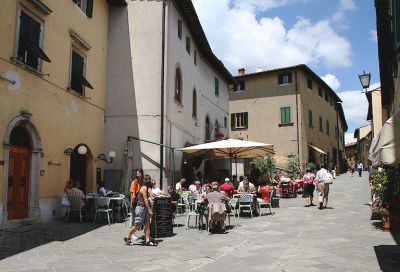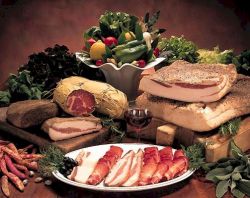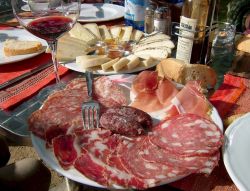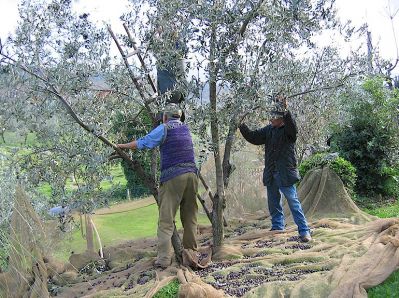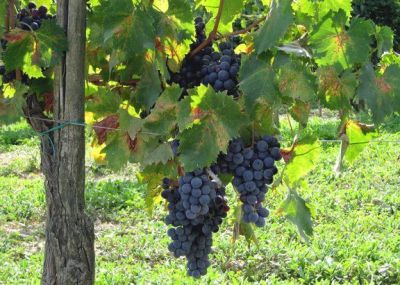Chianti Food, Wine and Olive Oil
Click the pictures for a larger view.
Food
Market Day in Castellina is every Saturday morning. In addition to household items, farm gear, clothes and shoes, fresh fruit and vegetables as well as cheese, porchetta and sometimes fresh fish are on sale at the booths and wagons.Click here for a comprehensive list of market days in Tuscany.
Like other traditional Tuscan food, Chianti dishes are prepared simply in the appropriate proportions and without unnecessary fuss, using fresh and authentic ingredients. A strong point in Chianti cuisine is game, which is still abundant. These dishes harmonise optimally with Chianti Classico wine, preferably comparatively aged bottles (4-7 years). Hare, pheasant, partridge and woodcock are common in the hunter’s game-bag. Wildfowl hunting, especially thrushes, used to be practised using live decoys. So-called ‘paretai’ (walls made of twigs) were used to capture birds with ‘pania’, a sort of bird lime obtained from mistletoe berries and spread onto the tree branches so that the birds that rested on them could no longer fly away. This hunting technique is forbidden, but it must noted that hunting has long been considered an important supply of food and a source of income as well. The game that was not consumed locally was sold to nearby markets for the tables of the rich families of Sienna and Florence.
Another popular tradition in the Chianti area, which has always provided superior quality food, is the art of making dressed pork: salami, finocchiona (coarse salami with fennel), sausages or salty meat like capocollo (pork shoulder) and ham, which make a snack a real meal. Local restaurants, both in towns but also out in the country, offer a wide selection of quality food and Chianti Classico of different vintages and brands. Prices are lower in the country restaurants.
More about food and wine in Chianti.
Olive oil
Olive groves are an important source of income for this area. The features of the soil contribute to make superior quality olive oil with less than 1% acid content ("extravergine"). The unique properties of the extra virgin olive oil produced in this region are the result of a combination of terrain, expertise and hard work: the olives are harvested by hand at the right time of maturation and then they are cold pressed using traditional methods. The cultivation of olive groves focuses more on quality rather than on quantity. Output is closely linked to the climate and it may be seriously affected by winter frost, as it was the case of the years 1956 and 1985, when the olive trees suffered heavy damage and many groves were completely destroyed.
More about Tuscan olive oil.
Wine
The oldest document in which the name CHIANTI is associated with the wine produced in the region dates back to 1398 and was signed by a member of the Mazzei family who still make wine at nearby Fonterutoli. It is kept in the archives of the famous merchant Francesco Datini from Prato. Numerous historic documents confirm that wine and olives have been cultivated for many centuries in this area. A parchment document dated 1202 and kept at Badia di Passignano contains references to the sale of land cultivated with vineyards in the region of the Grignano castle, while the so-called 'vin vermiglio', meaning 'cinnabar wine', was already famous in the 14 C. The Lega del Chianti (Chianti League), which was set up at that time, recognised the need for issuing rules to regulate wine production. One such example is the ban on starting the vintage before 29 September, St. Michael's Day, to prevent premature vintages from affecting the quality of wine.Dante, Cecco Angiolieri and Boccaccio all dealt with wine and knew well the red wine made from grapes grown in this area.
In 1924 a consortium for the protection of the Chianti Classico wine was founded. The identification mark is a black rooster or Gallo Nero, the same mark used by the old Lega del Chianti and the Castellina town council. In 1967 the entire Chianti region was granted the D.O.C., Controlled Denomination of Origin, and the exact area of production of Chianti Classico was identified in the territories of Castellina, Radda, Gaiole and part of the neighbouring villages.
In 1974, Chianti Classico wine was granted the D.O.C.G mark - Controlled and Guaranteed Denomination of Origin.

